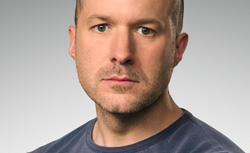Jonathan Ive, Designer, Apple
"A computer absolutely can be sexy."
Macworld, 1999. That was the year Apple introduced the iMac in five candy colors. The iMac was already a translucent computer that tried its best not to make you nervous. Now it strove to be even more welcoming, almost silly. And here was Apple's newish head of design, Jonathan Ive, talking about the product in a video—back when he let his hair grow and before he had permanently donned his dark T-shirt uniform. Even then, Ive had the confessional intimacy that makes him the star of Apple promotional videos today. His statement is so ridiculous that he laughs at it himself: "A computer absolutely can be sexy, it's um ... yeah, it can."
A decade later, no one would laugh (too loudly) if you said that an Apple product was sexy. Look at how we all caress our iPhones. This is not an accident. In interviews, Ive talks intensely about the tactile quality of industrial design. The team he runs at Apple is obsessed with mocking up prototypes. There is a now-legendary story from Ive's student days of an apartment filled with foam models of his projects. Watch this scene in the documentary Objectified where Ive explains the various processes used to machine a MacBook Air keyboard. He gazes almost longingly upon a titanium blank. This is a man who loves his materials.
Ive's fixation on how a product feels in your hand, and his micro-focus on aspects like the shininess of the stainless steel, or the exact amount of reflectivity in the screen, were first fully realized with the iPod. From that success, you can see how Ive and Steve Jobs led Apple to glory in the past decade. The iPod begat the iPhone, which in turned inspired the iPad. A new kind of tactile computing was born. Ive's primary concern for physicality, and his perfectionist desire to think through every aspect of the manufacturing process (even the boring parts), were the exact gifts needed to make a singular product like the iPhone a reality and to guide Apple products through a new era of human-computer interaction. Putting design first has reaped huge financial rewards: Apple is now vying with Exxon to be the world's most valuable company.
It's not always a good thing when one perfectionist meets another, but Ive can out-obsess the exacting Jobs. One way in which he differs from his boss is a personal, shambling humility that shows through in his design. I know that humility is not a word one associates with Apple products, but despite their often striking appearance, the point of an iPhone or an iMac is to emphasize the screen and otherwise recede into the background. Ive himself has said of a great product: "It feels inevitable. It feels almost undesigned." So part of what makes Ive's industrial design so successful is a contradiction: Products that make a strong initial emotional connection but then earn your lasting affection through a reserved Jeeves-like utility.
May I suggest a slogan for the box of the iPhone 5? "Undesigned by Apple in California."
Watch an excerpt from the documentary Objectifiedin which Ive talks about his design principles.
Check out the rest of our design Top Right:
Ben Fry, interactive designer
Phillip Lim, fashion designer
Jeanne Gang, architect
John Christakos and Maurice Banks, Blu Dot Furniture

